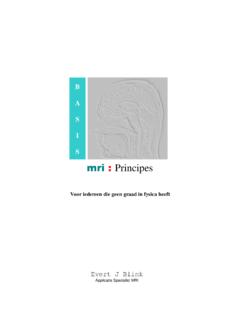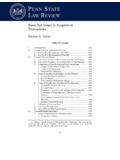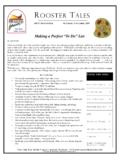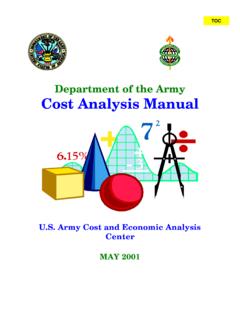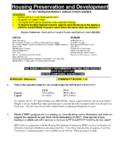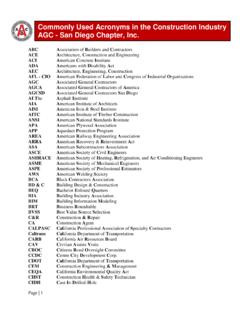Transcription of mri : Physics
1 Mri : Physics B. A. S. I. C. mri : Physics For anyone who does not have a degree in Physics Evert J Blink Application Specialist MRI. 0. mri : Physics Preface Over the years Magnetic Resonance Imaging, hereafter referred to as MRI, has become a popular and widely available means of cross sectional imaging modality. That is not coincidental;. MRI has gone through a fast paced round of development since its discovery. Now every self- respecting hospital or clinic has one or more MRI scanners to battle the conquest for more precise and accurate imaging and diagnosis of pathology. Even as we speak the development is still in full swing. Paired with its excellent image contrast resolution, MRI is harmless to the human body, within reason, through its use of radio waves and a magnetic field. This in contrast with X-ray s and CT. examinations, which use ionizing radiation. As MRI becomes more and more accepted the need for more qualified staff is also increasing.
2 Through the years operation of MRI scanners has become easier with each new software release, but this does not eliminate the need for proper understanding of how MRI works. MRI. works with a host of parameters, such as TR, TE, Flip Angle, Phase Encoding to name but a few. A thorough understanding of these parameters is vitally important in order to produce a successful MR image. There are numerous books on the bookshelves about MRI Physics , most of them aimed at those amongst us who are already experienced and have a fair understanding of Physics . Few books are written for the absolute beginner, who does not have a degree in Physics . As an application specialist I often have to explain the basic concept of MRI to people, most of the time radiographers, who do understand the Physics related to X-ray, but never got into contact with the Physics related to MRI. Having said that, nowadays radiography lectures also include MRI Physics .
3 Yet, these courses also use the same books aimed at experienced people. What I am trying to do here is to write about MRI Physics in such a way that everybody can understand the concept. It helps, of course, if one has been in contact with Physics , but it is not absolutely necessary. Once you have a reasonable understanding of the concept you can go ahead and pick up one of the more advanced books. One thing you should realize though. MRI Physics is highly complex if you want to know it all. You can dig into quantum Physics until you see green and still you may not be able to piece it all together. There are very few people who understand MRI to its full extent. The rest of us, mere mortals, grasp the basic concept. However, let this not discourage you, there is only so much you need to know, and luckily, that is not all that much, in order to do your job properly. Let me take the liberty of offering you some advice: keep reading about MRI.
4 Each time you reread the story you ll learn something new. And there will be a day that all the pieces come together. When this happens you are invited to read the story again and you will discover that there is still more to learn. Until then I hope this story will introduce you gently into the exciting world of MR Imaging: the one imaging modality that never gets boring. Evert Blink November, 2004. 1. mri : Physics Table Of Contents Contents PREFACE .. 1. A LITTLE MRI HISTORY .. 5. WHY MRI? .. 6. THE HARDWARE .. 6. MAGNET 6. Permanent magnets .. 6. Resistive Magnets .. 7. Superconducting magnets .. 7. RF 8. Volume RF 8. Surface coils .. 9. Quadrature Coils .. 9. Phased Array 9. OTHER HARDWARE .. 9. LET'S TALK Physics ..10. INTRODUCTION ..10. MAGNETIZATION ..10. EXCITATION ..14. RELAXATION ..15. T1 Relaxation ..15. T1 Relaxation Curves ..15. T2 Relaxation ..16. Phase and Phase coherence.
5 16. T2 Relaxation Curves ..17. ACQUISITION ..18. COMPUTING AND DISPLAY ..20. MORE Physics ..21. GRADIENT SIGNAL CODING ..22. Slice Encoding Phase Encoding Frequency Encoding Gradient ..25. Side Step: Gradient Specifications ..26. Side Step: Slice EVEN MORE Physics ..28. A JOURNEY INTO K-SPACE ..28. Filling k-Space Symmetry ..31. k-Space Filling Techniques ..32. PRACTICAL Physics I ..32. PULSE SEQUENCES ..32. SPIN ECHO (SE) SEQUENCE ..33. 2. mri : Physics Multi Slicing ..36. Multi Echo Sequence ..37. IMAGE CONTRAST ..38. T1 Contrast ..38. T2 Contrast ..38. Proton Density Contrast ..39. When To Use Which Contrast ..40. TURBO SPIN ECHO (TSE OR FSE) SEQUENCE ..41. FAST ADVANCED SPINE ECHO OR HASTE SEQUENCE ..42. GRADIENT ECHO (GE) INVERSION RECOVERY (IR) SEQUENCE ..44. STIR (Short Tau Inversion Recovery) Sequence ..45. FLAIR (Fluid Attenuated Inversion Recovery) Sequence ..45. CHOOSING THE RIGHT Sequence Pro's And Con's.
6 45. T1, T2 and PD Parameters ..46. PRACTICAL Physics II ..47. SEQUENCE Repetition Time (TR) ..47. Echo Time (TE)..48. Flip Angle (FA)..49. Inversion Time (TI) ..50. Number Of Acquisitions (NA or NEX) ..51. Matrix (MX) ..52. Field Of View (FOV) ..53. Slice Thickness (ST) ..54. Slice Gap (SG) ..55. Phase Encoding (PE) Direction I ..56. Phase Encoding (PE) Direction II ..57. Bandwidth (BW) ..57. IMAGE Motion Artifacts ..59. Para-Magnetic Artifacts ..60. Phase Wrap Artifacts ..60. Susceptibility Artifacts ..61. Clipping Artifact ..61. Spike Artifact ..63. Zebra Artifact ..63. A final word about artifacts ..63. FINAL WORDS ..64. APPENDIX ..65. TISSUE RELAXATION TIMES ..65. ACRONYMS ..66. RECOMMENDED READING ..70. RECOMMENDED READING ..70. Physics ..70. Clinical ..70. MRI ON THE INTERNET ..70. Physics ..70. INDEX ..71. ABOUT THE AUTHOR ..74. 3. mri : Physics COPYRIGHT NOTICE ..75. 4. mri : Physics A little MRI History The story of MRI starts in about 1946 when Felix Bloch proposed in a Nobel Prize winning paper some rather new properties for the atomic nucleus.
7 He stated that the nucleus behaves like a magnet. He realized that a charged particle, such as a proton, spinning around its own axis has a magnetic field, known as a magnetic momentum. He wrote down his finding in what we know as the Bloch Equations. It would take until the early 1950s before his theories could be verified experimentally. In 1960 Nuclear Magnetic Resonance spectrometers were introduced for analytical purposes. During the 1960s and 1970s NMR spectrometers were widely used in academic and industrial research. Spectrometry is used to analyze the molecular configuration of material based on its NMR spectrum. In the late 1960s Raymond Damadian discovered that malignant tissue had different NMR. parameters than normal tissue. He mused that, based on these differences, it should be possible to do tissue characterization. Based on this discovery he produced the first ever NMR image of a rat tumor in 1974.
8 In 1977 Damadian and his team constructed the first super conducting NMR. scanner (known as The Indomitable) and produced the first image of the human body, which took almost 5 hours to scan (Figure 1). At the same time Paul Lauterbur was pioneering in the same field. One could discuss who was responsible for bringing MRI to us, although, in all fairness, one could accept that both gentlemen had their contribution. The name Nuclear Magnetic Resonance (NMR) was changed into Magnetic Resonance Imaging (MRI) because it was believed that the word nuclear would not find wide acceptance amongst the public. The rest is, as they say, history. In the early 1980s just Figure 1 about every major medical imaging equipment manufacturer researched and produced MRI scanners. Since then a lot has happened in terms of development. The hardware and software became faster, more intelligent and easier to use.
9 Because of the development of advanced MRI pulse sequences more applications for MRI opened up, such as MR Angiography, Functional Imaging and Perfusion / Diffusion scanning. And yet, the end is not in sight. The development of MR is still in full swing and only time will tell what the future has in store for us. 5. mri : Physics Why MRI? When using x-rays to image the body one doesn t see very much. The image is gray and flat. The overall contrast resolution of an x-ray image is poor. In order to increase the image contrast one can administer some sort of contrast medium, such as barium or iodine based contrast media. By manipulating the x-ray parameters kV and mAs one can try to optimize the image contrast further but it will remain sub optimal. With CT scanners one can produce images with a lot more contrast, which helps in detecting lesions in soft tissue. The principle advantage of MRI is its excellent contrast resolution.
10 With MRI it is possible to detect minute contrast differences in (soft) tissue, even more so than with CT images. By manipulating the MR parameters one can optimize the pulse sequence for certain pathology. Another advantage of MRI is the possibility the make images in every imaginable plane, something, which is quite impossible with x-rays or CT. (With CT it is possible to reconstruct other planes from an axially acquired data set). However, the spatial resolution of x-ray images is, when using special x-ray film, excellent. This is particularly useful when looking at bone structures. The spatial resolution of MRI compared to that of x-ray is poor. In general one can use x-ray and CT to visualize bone structures whereas MRI is extremely useful for detecting soft tissue lesions. The Hardware MRI scanners come in many varieties. It s like going to the supermarket; you re spoiled for choice.
